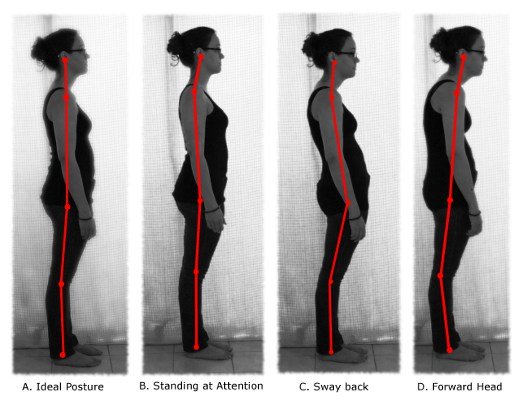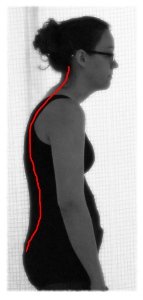Ways to Improve Posture: Stop Hurting Yourself!
Need to find ways to improve posture? Are you experiencing chronic pain? When you hold your body in unfavorable positions (bad posture), you eventually create muscle pain. I want to teach you how to avoid the pain and fix your posture. Have you ever noticed what good posture little kids have? This is because they are standing the way that uses the least amount of effort. They are not self conscious about how they look and haven't developed habitual muscle tension. Many of our posture problems are self inflicted. By tensing certain muscles, we distort our posture and create muscle pain. Good posture is not a static thing: it is using your structure well.

A. Ideal Posture - Notice that her ears align with her shoulders, hips, knees, and slightly in front of the ankles. Her spinal curves are present but not exaggerated. She is not exerting a lot of energy to maintain this position.
B. Standing at Attention - This one contrasts with A.
At first glance, it might look like good posture, and might even look
like what you do when finding ways to improve posture. However, notice
that she is holding her shoulders back stiffly, and is using a lot of
muscle energy to maintain this position. She will not be able to
maintain it long or to breath properly while using it. When I am
treating someone and say something about their posture, they go into
"attention" where they excessively stiffen, pull their shoulders up,
sometimes pinch them together. This isn't ideal posture either. In fact,
it is very uncomfortable and cannot be maintained for long at all.It often creates upper back pain.
C. Sway Back Posture - In this position, there is excessive curve in the low back, which can create a pinching sensation in the low back, and can close the space where the nerves exit the spine. If the spaces are already too small, you might put pressure on the nerves in this position.
D. Forward Head Posture - Here the neck muscles in the front of the neck are too tight so the chin juts forward and the chest caves in. There is also excessive rounding of the upper back. Together, these problems with posture can create headaches, trouble breathing and upper back pain.
Good posture is perfect balance. You need to think about opening and relaxing the areas that are pulling you off balance. Try this "postural exercise" based on the Alexander Technique. (This is best done in front of a full length mirror.)
Ways to improve posture by "letting go"
- First, stand as you normally would and just observe where you are.
- Don't try to change anything, just notice where you have tension and/or pain.
- Now put a hand behind your neck with your pinky finger against the bottom of your skull. Notice the tension in the muscles in the back of your neck.
- Release your neck and allow your head to balance forward and up.
- Release your torso and allow it to lengthen and widen. You will probably find you need to move you feet apart, even with your shoulders.
- Allow your legs to release away from your hips. Make sure you aren't locking your knees.
- Let your shoulders release to the sides. Let your whole arm to your hand hang freely.
- Notice your breathing... are you breathing? =) I often find people holding their breath when they think about posture.
- Make sure you are breathing with your diaphragm, allowing your belly to go out and in with each breath. Many people have trained themselves not to "belly breath" to keep a flat stomach.
- Take a look at yourself again, and check in with your body. Did your tension and pain change?
These techniques are great ways to improve posture, but you may have some areas that refuse to "release." This can be either due to stress or trigger points. For stress, I recommend meridian tapping, which is a technique where you tap on acupuncture meridians to help release stress stored in stress area of the brain. If the problem has a mechanical component, then work through your trigger points. Here are some areas to check:

Rounded shoulders — You need to work out the trigger points in the pectoralis major and pectoralis minor muscles. Focus on relaxing your chest and letting it fill with air on each breath. Don't push it, just focus on what is preventing your chest from expanding, and relax it.
Forward head posture — This is usually created by rounded shoulders, loss of curve in the low back, standing back on your heels. It is perpetuated by trigger points in the suboccipitals, upper trapezius muscles, splenius capitus and cervicis, the sternocleidomastoid muscles. Work through any trigger points you find. (Use the pictures at these links.) When you are standing, roll forward slightly toward the balls of your feet (as shown in A - Ideal Posture above). This helps your neck come back automatically, repositioning your head upward. Think of allowing your head to float upward toward the crown of your head (the upper back part).
Flattened back — This can be caused by trigger points in the abdominal muscles or hamstrings. Work out your trigger points and relax! Be careful not hold your stomach in. Make sure to breath with your diaphragm. Try pelvic tilts.
Excessive curve in the back — This can be caused by trigger points in the psoas, or by locking the knees. Try pelvic tilts and unlocking your knees to correct the problem.
If these ways to improve posture are not enough and you are asymmetrical side to side, I would recommend getting professional help, possibly some lessons in the Alexander Technique which teaches you how to release tension and move in a way that improves posture naturally. According to the British Medical Journal, it can help reduce back and neck pain.
Learn about more ways to improve posture with proper sitting posture exercises.
Return from Ways to Improve Posture to Home.